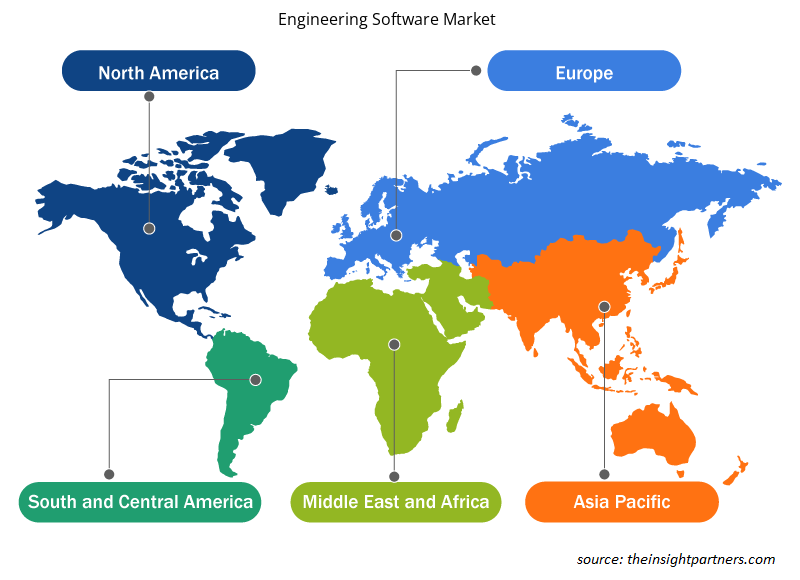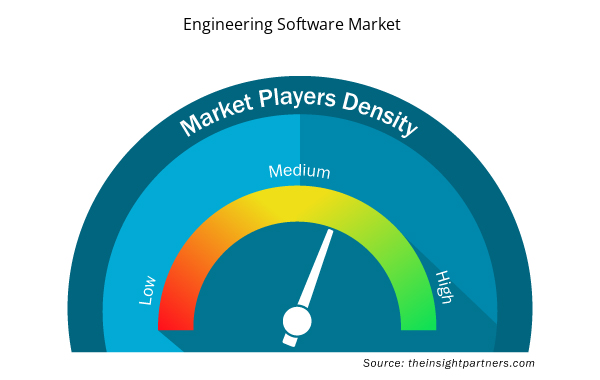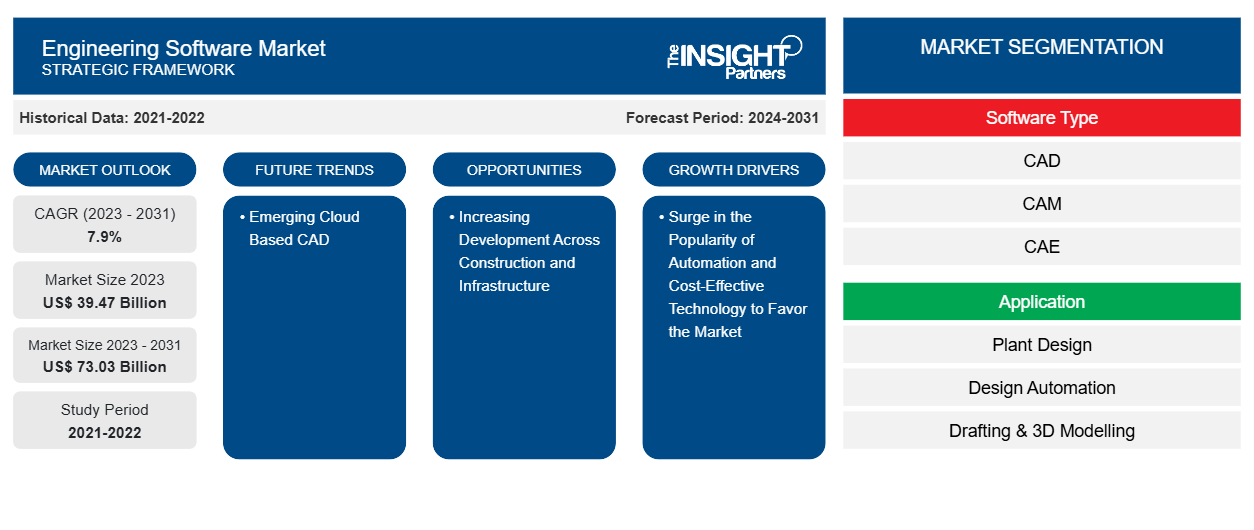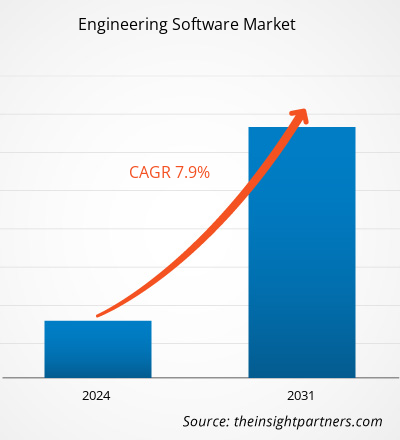Si prevede che la dimensione del mercato del software di ingegneria raggiungerà i 73,03 miliardi di dollari entro il 2031, rispetto ai 39,47 miliardi di dollari del 2023. Si prevede che il mercato registrerà un CAGR del 7,9% nel 2023-2031. L'aumento della popolarità dell'automazione e della tecnologia conveniente probabilmente rimarrà una tendenza chiave del mercato del software di ingegneria.
Analisi di mercato del software di ingegneria
Il crescente utilizzo di software CAD e CAE in una vasta gamma di settori, tra cui automotive, aerospaziale, edilizia e sanità, è responsabile dell'espansione del mercato. Il software per l'ingegneria comprende, tra le altre cose, progettazione assistita da computer (CAD), produzione assistita da computer (CAM) e ingegneria assistita da computer ( CAE ). Si prevede che il mercato del software di ingegneria si espanderà in modo significativo durante il periodo di previsione per una serie di motivi, tra cui la crescente domanda da parte delle aziende di ridurre i tempi e le spese di sviluppo del prodotto.
Panoramica del mercato del software di ingegneria
Ingegneri, progettisti e produttori possono scrivere documentazione ingegneristica critica, analizzare e simulare le prestazioni e le operazioni dei prodotti e sviluppare modelli complessi con l'aiuto di soluzioni software di ingegneria. Con le soluzioni basate su cloud, i membri del team possono collaborare da remoto utilizzando qualsiasi dispositivo scelgano perché possono essere accessibili tramite un browser Web. Di conseguenza, le aziende possono modernizzare e ridurre le spese hardware senza sacrificare la potenza di calcolo o l'utilità.
Personalizza questo report in base alle tue esigenze
Riceverai la personalizzazione gratuita di qualsiasi report, comprese parti di questo report, o analisi a livello nazionale, pacchetto dati Excel, oltre a usufruire di grandi offerte e sconti per start-up e università
- Scopri le principali tendenze di mercato in questo rapporto.Questo campione GRATUITO includerà analisi di dati che spaziano dalle tendenze di mercato alle stime e alle previsioni.
Driver e opportunità del mercato del software di ingegneria
Aumento della popolarità dell'automazione e della tecnologia conveniente per favorire il mercato.
Gli 0/0 e gli EPC degli impianti in tutto il mondo sono sotto pressione per ridurre gli errori di produzione e le spese operative a causa dell'intensificarsi della rivalità di mercato. Gli ingegneri degli impianti possono migliorare la qualità seguendo particolari standard internazionali durante i processi di progettazione, produzione e messa in servizio. I problemi di produzione e intensità possono essere risolti con software di progettazione , analisi in corso e aggiornamenti standard. Di conseguenza, le aziende in tutto il mondo stanno utilizzando sempre di più software di ingegneria per ridurre gli errori nella costruzione e nella produzione.
Aumento dello sviluppo nel settore delle costruzioni e delle infrastrutture
Si ritiene che uno dei principali fattori che contribuiscono allo sviluppo socioeconomico di qualsiasi paese sia l'edilizia. L'industria edile si sta espandendo rapidamente nelle nazioni in via di sviluppo in tutto il mondo, tra cui Etiopia, India, Cina, Brasile, Uzbekistan, Cambogia, Tanzania e Myanmar. Anche l'infrastruttura fondamentale di queste economie si sta sviluppando a un ritmo rapido. Ad esempio, le economie in via di sviluppo dell'Asia Pacifica e SAM stanno attirando molti investimenti diretti esteri nello sviluppo delle loro infrastrutture. Questi progressi stimoleranno anche la crescita delle loro infrastrutture e, con l'espansione dell'industria edile, aumenterà anche la necessità di software di ingegneria. Pertanto, si prevede che i progressi in espansione nei settori verticali delle infrastrutture e delle costruzioni offriranno.
Analisi della segmentazione del rapporto di mercato del software di ingegneria
I segmenti chiave che hanno contribuito alla derivazione dell'analisi di mercato del software di ingegneria sono il tipo di software e l'applicazione.
- In base al tipo di software, il mercato del software di ingegneria è suddiviso in CAD, CAM, CAE , AEC ed EDA . Si prevede che il segmento CAD crescerà nel periodo di previsione.
- Per applicazione, il mercato è segmentato in progettazione di impianti, automazione della progettazione , progettazione e modellazione 3D, progettazione e collaudo di prodotti e altri. Si prevede che il segmento dell'automazione della progettazione crescerà nel periodo di previsione.
Analisi della quota di mercato del software di ingegneria per area geografica
L'ambito geografico del rapporto sul mercato del software di ingegneria è principalmente suddiviso in cinque regioni: Nord America, Asia Pacifico, Europa, Medio Oriente e Africa e Sud America/Sud e Centro America. Il Nord America ha dominato il mercato del software di ingegneria. Le tendenze di adozione di tecnologie elevate in vari settori nella regione nordamericana hanno alimentato la crescita del mercato del software di ingegneria. Si prevede che fattori come l'adozione crescente di strumenti digitali e l'elevata spesa tecnologica da parte delle agenzie governative guideranno la crescita del mercato del software di ingegneria nordamericano. Inoltre, una forte enfasi sulla ricerca e sviluppo nelle economie sviluppate degli Stati Uniti e del Canada sta costringendo gli operatori nordamericani a portare sul mercato soluzioni tecnologicamente avanzate. Inoltre, gli Stati Uniti hanno un gran numero di operatori del mercato del software di ingegneria che si sono sempre più concentrati sullo sviluppo di soluzioni innovative. Tutti questi fattori contribuiscono alla crescita del mercato del software di ingegneria nella regione.
Approfondimenti regionali sul mercato del software di ingegneria
Le tendenze regionali e i fattori che influenzano il mercato del software di ingegneria durante il periodo di previsione sono stati ampiamente spiegati dagli analisti di Insight Partners. Questa sezione discute anche i segmenti e la geografia del mercato del software di ingegneria in Nord America, Europa, Asia Pacifico, Medio Oriente e Africa e America meridionale e centrale.

- Ottieni i dati specifici regionali per il mercato del software di ingegneria
Ambito del rapporto di mercato del software di ingegneria
| Attributo del report | Dettagli |
|---|---|
| Dimensioni del mercato nel 2023 | 39,47 miliardi di dollari USA |
| Dimensioni del mercato entro il 2031 | 73,03 miliardi di dollari USA |
| CAGR globale (2023-2031) | 7,9% |
| Dati storici | 2021-2022 |
| Periodo di previsione | 2024-2031 |
| Segmenti coperti | Per tipo di software
|
| Regioni e Paesi coperti | America del Nord
|
| Leader di mercato e profili aziendali chiave |
|
Densità dei player del mercato del software di ingegneria: comprendere il suo impatto sulle dinamiche aziendali
Il mercato del software di ingegneria sta crescendo rapidamente, spinto dalla crescente domanda degli utenti finali dovuta a fattori quali l'evoluzione delle preferenze dei consumatori, i progressi tecnologici e una maggiore consapevolezza dei vantaggi del prodotto. Con l'aumento della domanda, le aziende stanno ampliando le loro offerte, innovando per soddisfare le esigenze dei consumatori e capitalizzando sulle tendenze emergenti, il che alimenta ulteriormente la crescita del mercato.
La densità degli operatori di mercato si riferisce alla distribuzione di aziende o società che operano in un particolare mercato o settore. Indica quanti concorrenti (operatori di mercato) sono presenti in un dato spazio di mercato in relazione alle sue dimensioni o al valore di mercato totale.
Le principali aziende che operano nel mercato del software di ingegneria sono:
- PTC
- Automazione Rockwell, Inc.
- SAP SE
- Siemens
- Società anonima
- Autodesk Inc.
Disclaimer : le aziende elencate sopra non sono classificate secondo un ordine particolare.

- Ottieni una panoramica dei principali attori del mercato dei software di ingegneria
Notizie e sviluppi recenti sul mercato del software di ingegneria
Il mercato del software di ingegneria viene valutato raccogliendo dati qualitativi e quantitativi dopo la ricerca primaria e secondaria, che include importanti pubblicazioni aziendali, dati associativi e database. Di seguito è riportato un elenco degli sviluppi nel mercato:
- A febbraio 2024, - La società tecnologica globale Cognizant punta ad accelerare la modernizzazione aziendale espandendo la sua gamma di offerte di piattaforme. La società ha annunciato il lancio di Cognizant Flowsource, una piattaforma generativa abilitata all'intelligenza artificiale progettata per alimentare la nuova era dell'ingegneria del software.
(Fonte: Cognizant, Comunicato stampa, 2024)
- Nel giugno 2023, Nullspace, Inc. è stata lanciata come spin-off di IERUS Technologies, un affermato appaltatore della difesa di Huntsville, AL. Nullspace, Inc. si concentra sulla fornitura di software di ingegneria avanzata per applicazioni elettromagnetiche.
(Fonte: Nullspace, Comunicato stampa, 2023)
Copertura e risultati del rapporto sul mercato del software di ingegneria
Il rapporto "Dimensioni e previsioni del mercato del software di ingegneria (2021-2031)" fornisce un'analisi dettagliata del mercato che copre le seguenti aree:
- Dimensioni e previsioni del mercato a livello globale, regionale e nazionale per tutti i segmenti di mercato chiave coperti dall'ambito
- Dinamiche di mercato come fattori trainanti, vincoli e opportunità chiave
- Principali tendenze future
- Analisi dettagliata delle cinque forze PEST/Porter e SWOT
- Analisi di mercato globale e regionale che copre le principali tendenze di mercato, i principali attori, le normative e gli sviluppi recenti del mercato
- Analisi del panorama industriale e della concorrenza che copre la concentrazione del mercato, l'analisi della mappa di calore, i principali attori e gli sviluppi recenti
- Profili aziendali dettagliati
- Analisi storica (2 anni), anno base, previsione (7 anni) con CAGR
- Analisi PEST e SWOT
- Valore/volume delle dimensioni del mercato - Globale, regionale, nazionale
- Industria e panorama competitivo
- Set di dati Excel



Report Coverage
Revenue forecast, Company Analysis, Industry landscape, Growth factors, and Trends

Segment Covered
This text is related
to segments covered.

Regional Scope
North America, Europe, Asia Pacific, Middle East & Africa, South & Central America

Country Scope
This text is related
to country scope.
Domande frequenti
The global Engineering Software market is expected to reach US$ 73.03 billion by 2031.
The key players holding majority shares in the global Engineering Software market are PTC, Rockwell Automation, Inc., SAP SE, Siemens, Synopsys, Inc., Autodesk Inc., AVEVA, and Dassault Systèmes.
Increasing development across construction and infrastructure is impacting engineering software, which is anticipated to play a significant role in the global engineering software market in the coming years.
The surge in the popularity of automation and cost-effective technology is the major factors that propel the global engineering software market growth.
The global engineering software market was estimated to be US$ 39.47 billion in 2023 and is expected to grow at a CAGR of 7.9% during the forecast period 2024 - 2031.
Trends and growth analysis reports related to Technology, Media and Telecommunications : READ MORE..
The Insight Partners performs research in 4 major stages: Data Collection & Secondary Research, Primary Research, Data Analysis and Data Triangulation & Final Review.
- Data Collection and Secondary Research:
As a market research and consulting firm operating from a decade, we have published and advised several client across the globe. First step for any study will start with an assessment of currently available data and insights from existing reports. Further, historical and current market information is collected from Investor Presentations, Annual Reports, SEC Filings, etc., and other information related to company’s performance and market positioning are gathered from Paid Databases (Factiva, Hoovers, and Reuters) and various other publications available in public domain.
Several associations trade associates, technical forums, institutes, societies and organization are accessed to gain technical as well as market related insights through their publications such as research papers, blogs and press releases related to the studies are referred to get cues about the market. Further, white papers, journals, magazines, and other news articles published in last 3 years are scrutinized and analyzed to understand the current market trends.
- Primary Research:
The primarily interview analysis comprise of data obtained from industry participants interview and answers to survey questions gathered by in-house primary team.
For primary research, interviews are conducted with industry experts/CEOs/Marketing Managers/VPs/Subject Matter Experts from both demand and supply side to get a 360-degree view of the market. The primary team conducts several interviews based on the complexity of the markets to understand the various market trends and dynamics which makes research more credible and precise.
A typical research interview fulfils the following functions:
- Provides first-hand information on the market size, market trends, growth trends, competitive landscape, and outlook
- Validates and strengthens in-house secondary research findings
- Develops the analysis team’s expertise and market understanding
Primary research involves email interactions and telephone interviews for each market, category, segment, and sub-segment across geographies. The participants who typically take part in such a process include, but are not limited to:
- Industry participants: VPs, business development managers, market intelligence managers and national sales managers
- Outside experts: Valuation experts, research analysts and key opinion leaders specializing in the electronics and semiconductor industry.
Below is the breakup of our primary respondents by company, designation, and region:

Once we receive the confirmation from primary research sources or primary respondents, we finalize the base year market estimation and forecast the data as per the macroeconomic and microeconomic factors assessed during data collection.
- Data Analysis:
Once data is validated through both secondary as well as primary respondents, we finalize the market estimations by hypothesis formulation and factor analysis at regional and country level.
- Macro-Economic Factor Analysis:
We analyse macroeconomic indicators such the gross domestic product (GDP), increase in the demand for goods and services across industries, technological advancement, regional economic growth, governmental policies, the influence of COVID-19, PEST analysis, and other aspects. This analysis aids in setting benchmarks for various nations/regions and approximating market splits. Additionally, the general trend of the aforementioned components aid in determining the market's development possibilities.
- Country Level Data:
Various factors that are especially aligned to the country are taken into account to determine the market size for a certain area and country, including the presence of vendors, such as headquarters and offices, the country's GDP, demand patterns, and industry growth. To comprehend the market dynamics for the nation, a number of growth variables, inhibitors, application areas, and current market trends are researched. The aforementioned elements aid in determining the country's overall market's growth potential.
- Company Profile:
The “Table of Contents” is formulated by listing and analyzing more than 25 - 30 companies operating in the market ecosystem across geographies. However, we profile only 10 companies as a standard practice in our syndicate reports. These 10 companies comprise leading, emerging, and regional players. Nonetheless, our analysis is not restricted to the 10 listed companies, we also analyze other companies present in the market to develop a holistic view and understand the prevailing trends. The “Company Profiles” section in the report covers key facts, business description, products & services, financial information, SWOT analysis, and key developments. The financial information presented is extracted from the annual reports and official documents of the publicly listed companies. Upon collecting the information for the sections of respective companies, we verify them via various primary sources and then compile the data in respective company profiles. The company level information helps us in deriving the base number as well as in forecasting the market size.
- Developing Base Number:
Aggregation of sales statistics (2020-2022) and macro-economic factor, and other secondary and primary research insights are utilized to arrive at base number and related market shares for 2022. The data gaps are identified in this step and relevant market data is analyzed, collected from paid primary interviews or databases. On finalizing the base year market size, forecasts are developed on the basis of macro-economic, industry and market growth factors and company level analysis.
- Data Triangulation and Final Review:
The market findings and base year market size calculations are validated from supply as well as demand side. Demand side validations are based on macro-economic factor analysis and benchmarks for respective regions and countries. In case of supply side validations, revenues of major companies are estimated (in case not available) based on industry benchmark, approximate number of employees, product portfolio, and primary interviews revenues are gathered. Further revenue from target product/service segment is assessed to avoid overshooting of market statistics. In case of heavy deviations between supply and demand side values, all thes steps are repeated to achieve synchronization.
We follow an iterative model, wherein we share our research findings with Subject Matter Experts (SME’s) and Key Opinion Leaders (KOLs) until consensus view of the market is not formulated – this model negates any drastic deviation in the opinions of experts. Only validated and universally acceptable research findings are quoted in our reports.
We have important check points that we use to validate our research findings – which we call – data triangulation, where we validate the information, we generate from secondary sources with primary interviews and then we re-validate with our internal data bases and Subject matter experts. This comprehensive model enables us to deliver high quality, reliable data in shortest possible time.


 Ottieni un campione gratuito per questo repot
Ottieni un campione gratuito per questo repot